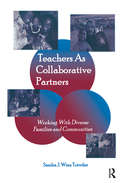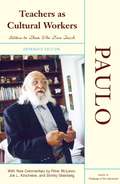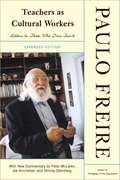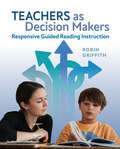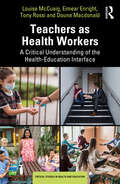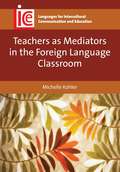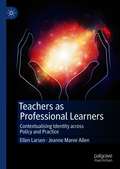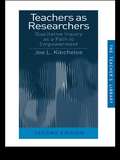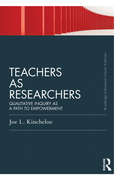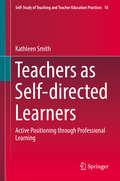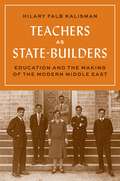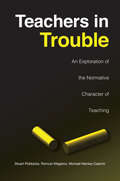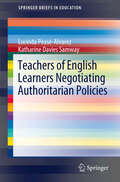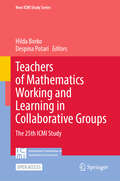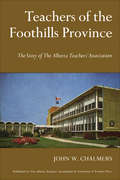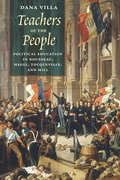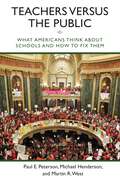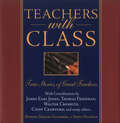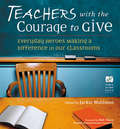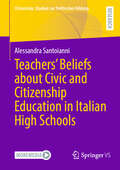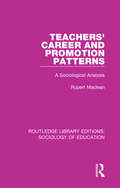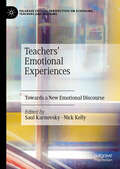- Table View
- List View
Teachers as Collaborative Partners: Working With Diverse Families and Communities (Inquiry And Pedagogy Across Diverse Contexts Ser.)
by Sandra J. TutwilerTeachers as Collaborative Partners assists future and inservice teachers in developing a research-based framework for understanding the dynamics of school, family, and community relations. It provides foundational knowledge important for understanding families and communities, while exploring conditions that influence family-school-community interactions. The text is designed to engage the critical reflective capability of teachers in ways that will support their ability to work with diverse families in a variety of teaching contexts.Part I focuses first on the social, cultural, and historical roots of the family, with specific attention to the evolution of public schools and the family as interdependent social institutions, and then on the multiple ways families conceive of and conduct family life, as well as the impact of community attributes on the work of families and schools.Part II explores the relationship among families, communities, and schools within social, political, legal, and educational contexts.Part III addresses educational practices that respond to authentic partnerships with families and communities.The goals of the text are supported by pedagogical tools that provide opportunities for readers to make connections between information in each chapter and realistic family-community-school situations.Case Studies are embedded in most chapters. These serve to complement research-based with authentic and personally articulated experiences of parents. Teachers then have the opportunity to make connections between theory and lived experiences.Each chapter includes Inquiry and Reflection questions and Guided Observations to engage readers in case study analysis, situated learning exercises, and classroom and community observations and reflections.The Family-Community-School Profile introduced in this text as a teacher-generated summary allows for evaluation of
Teachers as Cultural Workers
by Paulo FreireIn Teachers as Cultural Workers, Freire speaks directly to teachers about the lessons learned from a lifetime of experience as an educator and social theorist. Freire’s words challenge all who teach to reflect critically on the meaning of the act of teaching as well as the meaning of learning. He shows why a teacher’s success depends on a permanent commitment to learning and training, as part of an ongoing appraisal of classroom practice. By opening themselves to recognition of the different roads students take in order to learn, teachers will become involved in a continual reconstruction of their own paths of curiosity, opening the doors to habits of learning that will benefit everyone in the classroom. In essays new to this edition, well-known and respected educators Peter McLaren, Joe Kincheloe, and Shirley Steinberg add their reflections on the relevance of Freire’s work to the study and practice of education across the globe.
Teachers as Cultural Workers
by Paulo FreireIn Teachers as Cultural Workers, Freire speaks directly to teachers about the lessons learned from a lifetime of experience as an educator and social theorist. Freire’s words challenge all who teach to reflect critically on the meaning of the act of teaching as well as the meaning of learning. He shows why a teacher’s success depends on a permanent commitment to learning and training, as part of an ongoing appraisal of classroom practice. By opening themselves to recognition of the different roads students take in order to learn, teachers will become involved in a continual reconstruction of their own paths of curiosity, opening the doors to habits of learning that will benefit everyone in the classroom. In essays new to this edition, well-known and respected educators Peter McLaren, Joe Kincheloe, and Shirley Steinberg add their reflections on the relevance of Freire’s work to the study and practice of education across the globe.
Teachers as Cultural Workers: Letters to Those Who Dare Teach
by Paulo FreireThis book challenges all who teach to reflect critically on the meaning of the act of teaching as well as the meaning of learning. Freire speaks directly to teachers about lessons he has learned during a lifetime of experience as an educator.
Teachers as Decision Makers: Responsive Guided Reading Instruction
by Robin GriffithIn Teachers as Decision Makers: Responsive Guided Reading Instruction , Robin Griffith draws on years of research and countless interactions with students and teachers to present a framework of instructional decision making centered on the readers we work with, the books we share with them, and the instructional objectives we guide them toward.In this fresh look at the instructional choices we make, Griffith offers an in-depth guide in which you&’ll discover how to make effective, student-driven decisions, both while planning for and in the moments of teaching at the guided reading table, including: The Teacher Decision Making Framework, grounded in the learner, the goal, and the text Direct applications across three guided reading text level bands: Emergent, Early, and Transitional Tables, charts, and reproducible materials for easy reference in assessing and monitoring key reading behaviors at each band 50 quick reference Decision Guides for practical planning and responding in three instructional areas: Word Solving, Fluency and Expression, and Comprehension Whether you&’re new to guided reading or looking to refine your practice, this practical resource will give you the tools you need to elevate your instruction and refine your ability to make effective decisions when teaching young readers.
Teachers as Health Workers: A Critical Understanding of the Health-Education Interface (Critical Studies in Health and Education)
by Doune Macdonald Louise McCuaig Tony Rossi Eimear EnrightSchooling has long been held responsible for the health and well-being of children. However, against an international background of rising concern about students’ performance and well-being, schools and teachers have faced escalating expectations of their health-related work. While various stakeholders have ideas about what teachers’ health work entails, we know little about teachers’ contributions, engagement and personal satisfaction with this work. As teachers’ work represents a significant national investment, insight into the cost–benefit of teachers’ health work is vital to establishing the broader economic contribution of schools to society. Teachers as Health Workers offers a critical perspective on these matters, documenting the day-to-day work of Australian teachers as they grapple with the challenges, and joys, of balancing education and health-related responsibilities. Whilst shifts in policy, economics and globalisation influence localised enactment of teachers’ health work, the economic modelling, theorising and methodological innovations of this research address enduring themes and challenges. Consequently, this book’s critical perspective reveals policy-practice gaps in government strategies seeking to create a healthy and productive population. The book will inform education, health and industrial policies and provide direction for teachers’ initial or ongoing preparation as health workers.
Teachers as Mediators in the Foreign Language Classroom
by Michelle KohlerLanguage teachers are key figures in preparing young people for participation in an increasingly multilingual and culturally diverse world, yet little is known about how they go about this in practice. This book uses examples of classroom interaction to reveal how teachers of languages act as intercultural mediators and the implications of this for practice. To date, there has been little exploration of how teachers mediate language and culture learning from an intercultural perspective, and what underlies their mediation practices in terms of their conceptions of intercultural language teaching and learning. This book offers an account of what teachers are thinking, feeling and doing as they enact an intercultural perspective on language teaching and learning.
Teachers as Professional Learners: Contextualising Identity across Policy and Practice
by Ellen Larsen Jeanne Maree AllenDrawing upon data from an Australian study, this book gives voice to beginning teachers navigating their way through their first year of teaching and discovering what it means to be professional learners. The chapters within provide rich insights into the ways in which beginning teachers make sense of the new and challenging experiences they face during the first year of teaching, and how these influence the development of their learner identities at this formative time of their careers. Professional learning, in response to teacher standards and associated accountability measures, often fails to acknowledge the importance of internal motivation and attitude to beginning teachers’ sense of a professional learner identity. This book offers policy makers, teacher educators, school leaders, mentors and teachers a way of thinking about how beginning teachers can be supported to grow professionally and construct their identities as professional learners.
Teachers as Researchers in Innovative Learning Environments: Case Studies from Australia and New Zealand Schools
by Wesley Imms Julia E. MorrisThis book presents and discusses the results of the ‘Plans to Pedagogy’ (P2P) project that was implemented across 13 diverse Australian and New Zealand schools, each with a unique school context and specific learning environment issue. The project employed a participatory approach, where academic researchers partnered with school leaders and staff in each school to co-design, implement, and evaluate research targeting the school’s chosen issue. It explores and analyses the case studies from the project and discusses a range of topics, including how space can be used as a pedagogic tool, determining the affordances of learning environments to engage students, how teacher collaboration can be enhanced in flexible spaces, and how furniture influences student engagement and teacher pedagogies. It also provides school leaders with authentic examples of how research can be utilised to drive evidence-based discussions about teacher practices and student learning. Finally, it also illustrates how teachers can design and implement powerful studies that underpin better pedagogies in their schools.
Teachers as Researchers: Qualitative Inquiry as a Path to Empowerment (Teachers' Library)
by Joe L. KincheloeThis book urges teachers - as both producers and consumers of knowledge - to engage in the debate about educational research by undertaking meaningful research themsleves. Teachers are now being encouraged to carry out research in order to improve their effectiveness in the classroom, but this book suggests that they also reflect on and challenge the reductionist and technicist methods that promote a 'top down' system of education. The author, a leading proponent of qualitative research, argues that only by engaging in complex, critical research will teachers rediscover their professional status, empower their practice in the classroom and improve the quality of education for their pupils. Postgraduate students of education and experienced teachers will find much to inspire and encourage them in this book. Updated and revised for this new edition, it retains both its clarity and insistence on sound research practice. Joe L. Kincheloe is Professor of Education at the City University of New York Graduate Center and Brooklyn College. he is the author and editor of many books on critical pedagogy and qualitative research in education. Series Editor: Ivor F. Goodson.
Teachers as Researchers: Qualitative inquiry as a path to empowerment (Teachers' Library)
by Joe L KincheloeTeachers as Researchers urges teachers - as both producers and consumers of knowledge - to engage in the debate about educational research by undertaking meaningful research themselves. Teachers are being encouraged to carry out research in order to improve their effectiveness in the classroom, but this book suggests that they also reflect on and challenge the reductionist and technicist methods that promote a 'top down' system of education. It argues that only by engaging in complex, critical research will teachers rediscover their professional status, empower their practice in the classroom and improve the quality of education for their pupils. Now re-released to introduce this classic guide for teachers, the new edition of Teachers as Researchers now also includes an introductory chapter by Shirley R. Steinberg that sets the book within the context of both the subject and the historical perspective. In addition, she also provides information on some key writing that extends the bibliography of this influential book thereby bringing the material fully up to date with current research. Postgraduate students of education and experienced teachers will find much to inspire and encourage them in this definitive book.
Teachers as Self-directed Learners
by Kathleen SmithThis book redefines teacher in-service education as being less about participation in a program and more about the opportunity for teachers to experience a process of learning that is personally meaningful and contextually relevant to their own teaching practice. The research presented here reveals that teachers have the capacity to think and work differently, yet are rarely provided with opportunities to exercise active decision-making about their personal learning needs. Creating and implementing such an approach involves reimagining all aspects of the learning experience so that teachers are free to articulate their own learning needs and actively work to determine what matters most for their professional practice. The book breaks new ground by drawing from research related to an in-service program where teachers, their experience and professional thinking were deliberately positioned at the centre of the learning experience. Using this evidenced-based approach, it focuses not only on the learning achieved, but also the conditions that enabled teachers to undertake such learning.
Teachers as State-Builders: Education and the Making of the Modern Middle East
by Hilary Falb KalismanThe little-known history of public school teachers across the Arab world—and how they wielded an unlikely influence over the modern Middle EastToday, it is hard to imagine a time and place when public school teachers were considered among the elite strata of society. But in the lands controlled by the Ottomans, and then by the British in the early and mid-twentieth century, teachers were key players in government and leading formulators of ideologies. Drawing on archival research and oral histories, Teachers as State-Builders brings to light educators’ outsized role in shaping the politics of the modern Middle East.Hilary Falb Kalisman tells the story of the few young Arab men—and fewer young Arab women—who were lucky enough to teach public school in the territories that became Iraq, Jordan, and Palestine/Israel. Crossing Ottoman provincial and, later, Mandate and national borders for work and study, these educators were advantageously positioned to assume mid- and even high-level administrative positions in multiple government bureaucracies. All told, over one-third of the prime ministers who served in Iraq from the 1950s through the 1960s, and in Jordan from the 1940s through the early 1970s, were former public school teachers—a trend that changed only when independence, occupation, and mass education degraded the status of teaching.The first history of education across Britain’s Middle Eastern Mandates, this transnational study reframes our understanding of the profession of teaching, the connections between public education and nationalism, and the fluid politics of the interwar Middle East.
Teachers in Trouble: An Exploration of the Normative Character of Teaching
by Michael Manley-Casimir Romulo Magsino Stuart PiddockeThe teacher who has an affair with a student. The teacher who is a transvestite. The teacher who advocates personal beliefs. These are 'teachers in trouble.' Their behaviour, whether it occurs in the classroom or off the job, offends the community and brings down censure from the school board.At root, schools are cultural institutions and teaching, a cultural activity. Teachers are expected to shape students according to accepted community norms. They interpret and apply curricula - and can divert curricula from their intended purpose. Teachers are at the eye of the vortex in the struggle for control over education, buffeted by the forces of social change and conflicting public expectations. The authors of this book examine how teacher conduct is monitored and what types of misconduct can produce 'social dramas.' Boards of reference have been established to arbitrate disputes between school boards and teachers who are dismissed. Drawing on the decisions of these boards of reference across Canada, the authors identify normative issues and propose a classification scheme for contentious behaviours.Teachers in Trouble poses fundamental questions about the role of teachers in society. It is an invaluable guide for teachers and professional organizations, education administrators, and members of the community who are concerned about ethics in our schools.
Teachers of English Learners Negotiating Authoritarian Policies
by Lucinda Pease-Alvarez Katharine Davies SamwayIn an effort to reverse the purported crisis in U.S. public schools, the federal government, states, districts have mandated policies that favor standardized approaches to teaching and assessment. As a consequence, teachers have been relying on teacher-centered instructional approaches that do not take into consideration the needs, experiences, and interests of their students; this is particularly pronounced with English learners (ELs). The widespread implementation of these policies is particularly striking in California, where more than 25% of all public school students are ELs. This volume reports on three studies that explore how teachers of ELs in three school districts negotiated these policies. Drawing on sociocultural and poststructural perspectives on agency and power, the authors examine how contexts in which teachers of ELs lived and worked influenced the messages they constructed about these policies and mediated their decisions about policy implementation. The volume provides important insights into processes affecting the learning and teaching of ELs.
Teachers of Mathematics Working and Learning in Collaborative Groups: The 25th ICMI Study (New ICMI Study Series)
by Despina Potari Hilda BorkoThis open access book is the product of an international study which offers a state-of-the-art summary of mathematics teacher collaboration with respect to theory, research, practice, and policy. The authors – leading researchers and teachers on mathematics teacher collaboration – represent a wide range of countries and cultures. Chapters explore the various forms of teacher collaboration; the diversity of settings and groupings in which mathematics teacher collaboration occurs; the tools and resources that support mathematics teacher collaboration and are the product of collaboration; and the breadth of outcomes of such collaboration. Teachers’ experiences and learning in collaborative settings are represented through their own voices as well as the voices of researchers. Forms and outcomes of collaboration are considered through a variety of theoretical perspectives and methodological approaches. The authors reflect on the policy implications of this work and suggest new directions of research that take into account contextual, cultural, national and political dimensions that impact teachers’ work and learning through collaboration. The book is a valuable resource for researchers, practitioners, and policy makers who are interested in the power of teacher collaboration, and its history and potential for promoting educational innovations and equitable experiences for all teachers and learners.
Teachers of the Foothill Province: The Story of The Alberta Teachers' Association
by John ChalmersIn 1967 the Alberta Teachers' Association published, in honour of Canada's Centennial, a history of the public school system in Alberta entitled Schools of the Foothills Province. This informative book published for the Association by University of Toronto Press is now followed by a companion volume written by the same author, which tells the story of the Association itself, and its long and sturdy efforts to improve the position of teachers and the quality of education in the province. After providing the background to the formation of the ATA (which officially began on July 24, 1918) the author goes on to describe the growth of the organization from its beginnings as a spare-time activity for teachers to a strong influential union. From its earliest years it was affiliated with the labour movements of the Twenties, and fought with increasing strength for the rights of Alberta teachers. Throughout this study, the ATA's concern is evident not only for the economic aspects of teaching for higher salaries and pension schemes, but also for other features: departmental examinations and curricula, preparation and certification of teachers, and educational research.The ATA's mercurial relations with the provincial government are related, its struggle through the depression years and its blossoming in the first decade after 1935 under a Social Credit Government. Leading personalities move through this story against the turbulent background of a growing young province, contributing an air of vigorous controversy and achievement to the story of the ATA.
Teachers of the People: Political Education in Rousseau, Hegel, Tocqueville, and Mill
by Dana Villa2016 witnessed an unprecedented shock to political elites in both Europe and America. Populism was on the march, fueled by a substantial ignorance of, or contempt for, the norms, practices, and institutions of liberal democracy. It is not surprising that observers on the left and right have called for renewed efforts at civic education. For liberal democracy to survive, they argue, a form of political education aimed at “the people” is clearly imperative. In Teachers of the People, Dana Villa takes us back to the moment in history when “the people” first appeared on the stage of modern European politics. That moment—the era just before and after the French Revolution—led many major thinkers to celebrate the dawning of a new epoch. Yet these same thinkers also worried intensely about the people’s seemingly evident lack of political knowledge, experience, and judgment. Focusing on Rousseau, Hegel, Tocqueville, and Mill, Villa shows how reformist and progressive sentiments were often undercut by skepticism concerning the political capacity of ordinary people. They therefore felt that “the people” needed to be restrained, educated, and guided—by laws and institutions and a skilled political elite. The result, Villa argues, was less the taming of democracy’s wilder impulses than a pervasive paternalism culminating in new forms of the tutorial state. Ironically, it is the reliance upon the distinction between “teachers” and “taught” in the work of these theorists which generates civic passivity and ignorance. And this, in turn, creates conditions favorable to the emergence of an undemocratic and illiberal populism.
Teachers versus the Public
by Paul E. Peterson Martin R. West Michael HendersonA comprehensive exploration of 21st Century school politics, Teachers versus the Public offers the first comparison of the education policy views of both teachers and the public as a whole, and reveals a deep, broad divide between the opinions held by citizens and those who teach in the public schools. Among the findings: Divisions between teachers and the public are wider and deeper than differences between other groups often thought to contest school policy, such as Republicans and Democrats, the young and the old, the rich and the poor, or African Americans and whites. The teacher-public gap is widest on such issues as merit pay, teacher tenure reform, impact of teacher unions, school vouchers, charter schools, and requirements to test students annually. Public support for school vouchers for all students, charter schools, and parent trigger laws increases sharply when people are informed of the national ranking of student performance in their local school district. Public willingness to give local schools high marks, its readiness to support higher spending levels, and its support for teacher unions all decline when the public learns the national ranking of their local schools. On most issues, teacher opinion does not change in response to new information nearly as much as it does for the public as a whole. In fact, the gap between what teachers and the public think about school reform grows even wider when both teachers and the public are given more information about current school performance, current expenditure levels, and current teacher pay.The book provides the first experimental study of public and teacher opinion. Using a recently developed research strategy, the authors ask differently worded questions about the same topic to randomly chosen segments of representative groups of citizens. This approach allows them to identify the impact on public opinion of new information on issues such as student performance and school expenditures in each respondent's community.The changes in public opinion when citizens receive information about school performance are largest in districts that perform below the national average. Altogether, the results indicate that support for many school reforms would increase if common core state standards were established and implemented in such a way as to inform the public about the quality of their local schools. These and many other findings illuminate the distance between teacher opinions and those of the public at large.About the Research: In partnership with the Harvard Program on Education Policy and Governance and the journal, Education Next, authors Paul E. Peterson, Martin West and Michael Henderson surveyed nationally representative samples of teachers and the public as a whole annually between 2007 and 2013.
Teachers versus the Public
by Paul E. Peterson Martin R. West Michael HendersonA comprehensive exploration of 21st Century school politics, Teachers versus the Public offers the first comparison of the education policy views of both teachers and the public as a whole, and reveals a deep, broad divide between the opinions held by citizens and those who teach in the public schools. Among the findings: Divisions between teachers and the public are wider and deeper than differences between other groups often thought to contest school policy, such as Republicans and Democrats, the young and the old, the rich and the poor, or African Americans and whites. The teacher-public gap is widest on such issues as merit pay, teacher tenure reform, impact of teacher unions, school vouchers, charter schools, and requirements to test students annually. Public support for school vouchers for all students, charter schools, and parent trigger laws increases sharply when people are informed of the national ranking of student performance in their local school district. Public willingness to give local schools high marks, its readiness to support higher spending levels, and its support for teacher unions all decline when the public learns the national ranking of their local schools. On most issues, teacher opinion does not change in response to new information nearly as much as it does for the public as a whole. In fact, the gap between what teachers and the public think about school reform grows even wider when both teachers and the public are given more information about current school performance, current expenditure levels, and current teacher pay.The book provides the first experimental study of public and teacher opinion. Using a recently developed research strategy, the authors ask differently worded questions about the same topic to randomly chosen segments of representative groups of citizens. This approach allows them to identify the impact on public opinion of new information on issues such as student performance and school expenditures in each respondent's community.The changes in public opinion when citizens receive information about school performance are largest in districts that perform below the national average. Altogether, the results indicate that support for many school reforms would increase if common core state standards were established and implemented in such a way as to inform the public about the quality of their local schools. These and many other findings illuminate the distance between teacher opinions and those of the public at large.About the Research: In partnership with the Harvard Program on Education Policy and Governance and the journal, Education Next, authors Paul E. Peterson, Martin West and Michael Henderson surveyed nationally representative samples of teachers and the public as a whole annually between 2007 and 2013.
Teachers with Class: True Stories of Great Teachers
by Marsha Serling GoldbergTeachers with Class celebrates teachers and the art of good teaching. Almost everyone has had a special teacher at some point-one who saw potential where others did not, one who made ideas come alive, one who taught more than what was in the textbook. In Teachers with Class, 30 famous and not-so-famous people thank their favorite teachers with essays that praise the difference a good teacher makes.James Earl Jones honors the high school English teacher who helped him overcome his stutter and learn to speak comfortably out loud. An architect recalls a teacher's belief in the unlikeliest student. Three-time Pulitzer Prize-winner, Thomas Friedman, remembers the teacher who inspired his career in journalism by imparting lessons that are relevant today. One man tells of the math teacher whose patience and guidance gave him the confidence to succeed as a physician and researcher. These stories will spark memories about the special teachers in your own life. To say "thank you," use the list of grants and awards for teachers featured in the book to nominate a teacher who made a positive impact on your life. A portion of the proceeds from Teachers with Class will go to the National Education Association (NEA) Foundation.
Teachers with the Courage to Give: Everyday Heroes Making a Difference in Our Classrooms (Call to Action Books)
by Jackie WaldmanJackie Waldman, the author of The Courage to Give and Teens with the Courage to Give, now presents the stories of forty-two incredible teachers and the ways they went beyond the call of duty to make a difference in the lives of their students. In these inspiring pages you'll meet Trish Hill, a teacher from Ft. Worth, Texas, who underwent radiation and chemotherapy without missing a day of school because her first graders gave her energy and courage; and Alison Frost, a drama teacher in Houston who makes casting decisions knowing that the role may be better for the student than the student for the role. Then there's Francis Mustapha, a teacher born in a small village in Africa, who teaches in Fort Wayne, Indiana, and used a student's suicide to create an opportunity for other students to succeed. Through their courageous first-person stories, these men and women prove that teachers are true everyday heroes. "Each of us remembers the teacher who made a difference in our life--that special person who has given us a glimpse of what we may accomplish or who we may become. By honoring teachers, and learning their lessons, we will co-create a safer, kinder world." -Jackie Waldman
Teachers' Beliefs about Civic and Citizenship Education in Italian High Schools (Citizenship. Studien zur Politischen Bildung)
by Alessandra SantoianniVarious social and political actors are responsible to educate citizens to sustain democracy. Civic and Citizenship Education (CCE) addresses this issue and has gained prominence. Italy made the subject compulsory in schools with the law n.92/2019. Different conceptualisations of CCE have the notion of citizenship at the centre, which can differentiate between traditional and critical approaches. Despite this, little is known about what teachers believe in terms of citizenship and what the subject should involve in terms of goals, content and methods. This work aims to understand Italian teachers' views on CCE and its implementation and contribute to its systematisation as a scientific discipline. The author interviewed Italian high school teachers and analysed the results. The results show that teachers’ beliefs about the goals of CCE relate to broad social and political issues and students’ learning. These beliefs also show civic republican values. Three macro-areas of content from the 92/2019 law serve as a framework for teachers to select topics they believe are relevant, and Lawfulness Education is the key to the content, goals and teaching strategies. Teachers are unclear whether CCE should be a separate, transversal or integrated subject. Ultimately, they implement what they believe in despite the policy changes introduced by the 92/2019 law.
Teachers' Career and Promotion Patterns: A Sociological Analysis (Routledge Library Editions: Sociology Of Education Ser. #33)
by Rupert MacleanFirst published in 1992, this book shows that despite appearances and beliefs to the contrary, teachers go in for career planning just as systematically as the members of any other profession and that the career movement of teachers is patterned not random. It demonstrates that status and rewards matter, but so do teaching locations and conditio
Teachers' Emotional Experiences: Towards a New Emotional Discourse (Palgrave Critical Perspectives on Schooling, Teachers and Teaching)
by Nick Kelly Saul KarnovskyThis edited book seeks to address the impoverished culture of emotional discourse in the teaching profession and teacher education. Teachers across the world live out emotional experiences in their professional lives (in the classroom, in the staffroom, online) yet the language available for talking about these experiences is fragmented and often inadequate. The book draws on a broad range of theories including psychoanalytic, critical, feminist, sociological and poststructural to expand a rich conceptual language for talking about teachers’ emotional experiences, originating from the authentic voices of teachers themselves. The book is unified by the inclusion of unpublished, first-hand accounts of teachers, drawn from the editors’ own empirical research interviewing a diverse group of teachers over many years. Each chapter includes a direct voice of a teacher telling their own story, in their own words, about an experience they found to be emotionally significant—the challenging, the sublime, and the downright distressing. Scholarly responses to each of these interviews weave a novel imagining for teachers’ emotional discourse within schools. The chapters discuss the complex contexts of teachers’ professional-emotional lives, such as neoliberal school systems, fraught relationships with leaders, contractualisation, toxic positivity, intractable behaviour problems and datafication. The book will be useful for education researchers, scholars of teachers and teacher education as well as teachers themselves, their families, and those who wish to work with and understand the complex dynamics of the teaching profession.
